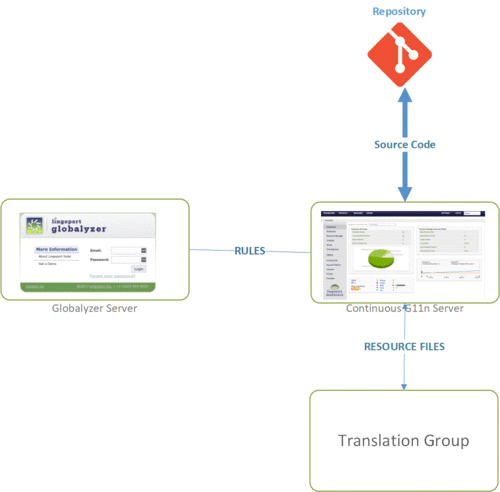Difference between revisions of "Deployment and Security"
(→Typical Deployment and Ports) |
(→Ports) |
||
| (11 intermediate revisions by 3 users not shown) | |||
| Line 1: | Line 1: | ||
| − | = Introduction = |
||
| − | A number of actors need access to the Dashboard and Jenkins. In addition, installation and configuration require some basic items, such as access to Jenkins plugins sites and SonarQube plugin site, SMTP email to send notifications, and SSH access for those in charge of setting up the system. |
||
| + | = Typical Deployment of the Lingoport Suite and Ports = |
||
| − | |||
| − | = Typical Deployment and Ports = |
||
Setting up the Suite on a Customer's system can be done in many ways, as shown in the different deployment scenarios. The following is meant to show the necessary access to the system. |
Setting up the Suite on a Customer's system can be done in many ways, as shown in the different deployment scenarios. The following is meant to show the necessary access to the system. |
||
| + | * The code repository needs to be able to work with the Continuous Globalization Server. This is done through the Jenkins jobs and Lingobot. |
||
| + | * The Continuous Globalization Server needs to be able to access the Globalyzer rulesets that are located either on our hosted server or on a local server. |
||
| + | * The Continuous Globalization Server needs to be able to send and receive resource files with the Translation Management System. |
||
| + | ** The resource files are also stored in the code repository. |
||
| + | * Additionally, there are administrative needs for Continuous Globalization Server to be able to access Jenkins plugins, SMTP email, and SSH access. |
||
| + | [[File:Deployment - Wiki.gif|500px]] |
||
| − | *The Customer's systems are shown in Light Blue; <b>CentOS</b> for the main system where Jenkins and Dashboard reside. |
||
| − | *Access from outside the Customer's system are shown in Light Green. |
||
| − | |||
| − | [[Image:Deployment and Security.gif]] |
||
= Ports = |
= Ports = |
||
| + | Please see [[Deployment_Scenarios#External_Access_and_Ports |External Access and Ports]]. |
||
| − | * Jenkins is accessed via port 8080 |
||
| − | * Lingoport Dashboard is accessed via port 9000 |
||
| − | * The Translation Vendor may be accessed by different means, for instance port 21 for FTP or port 22 for SFTP. |
||
| − | * Access for the Lingoport (or internal) installation team can be done in many ways, such as SSH for Telnet or Putty. |
||
| − | * The system must be able to access https://globalyzer.com. |
||
= Other aspects = |
= Other aspects = |
||
* Jenkins installation requires access to the Jenkins update site, http://updates.jenkins-ci.org |
* Jenkins installation requires access to the Jenkins update site, http://updates.jenkins-ci.org |
||
* Dashboard may require access to the SonarQube update site, http://update.sonarsource.org |
* Dashboard may require access to the SonarQube update site, http://update.sonarsource.org |
||
| − | * Notifications are sent using an SMTP account: The system must allow access to an SMTP server (e.g. Google) |
+ | * Notifications are sent using an SMTP account: The system must allow access to an SMTP server (e.g. smtp.gmail.com for Google) |
Latest revision as of 23:11, 22 January 2020
Typical Deployment of the Lingoport Suite and Ports
Setting up the Suite on a Customer's system can be done in many ways, as shown in the different deployment scenarios. The following is meant to show the necessary access to the system.
- The code repository needs to be able to work with the Continuous Globalization Server. This is done through the Jenkins jobs and Lingobot.
- The Continuous Globalization Server needs to be able to access the Globalyzer rulesets that are located either on our hosted server or on a local server.
- The Continuous Globalization Server needs to be able to send and receive resource files with the Translation Management System.
- The resource files are also stored in the code repository.
- Additionally, there are administrative needs for Continuous Globalization Server to be able to access Jenkins plugins, SMTP email, and SSH access.
Ports
Please see External Access and Ports.
Other aspects
- Jenkins installation requires access to the Jenkins update site, http://updates.jenkins-ci.org
- Dashboard may require access to the SonarQube update site, http://update.sonarsource.org
- Notifications are sent using an SMTP account: The system must allow access to an SMTP server (e.g. smtp.gmail.com for Google)
